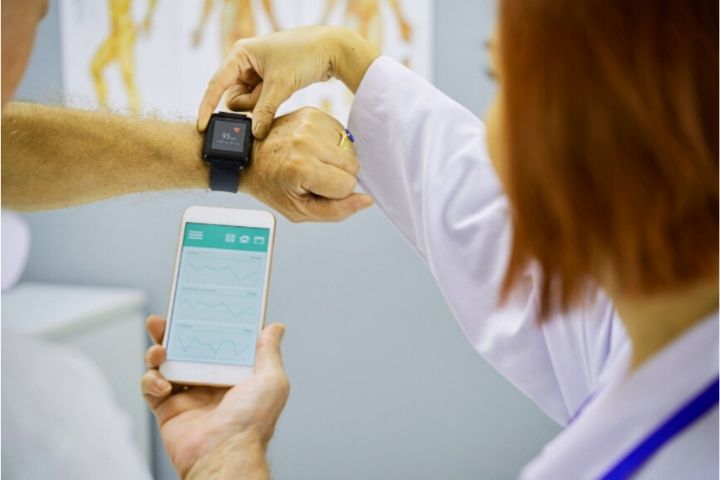Did you know one in six consumers owns a wearable device? Smartwatches vastly improve our everyday lives: they track our daily steps, monitor our heart rate, allow us to make phone calls, and pay for things we buy. Wearable technology is not only popular among people who want to track their fitness levels, but it’s also becoming more common among seniors to monitor their health.
A report by Markets and Markets found that the wearable technology market in healthcare is expected to reach USD $12.1 billion by 2021. So why is this sector in technology growing so rapidly? The main reason is due to our aging population.
In the US, the number of Americans aged 65 and older is predicted to double from 52 million in 2018 to 95 million by 2060 according to the Population Reference Bureau. Many challenges come with an aging population including a rise in the number of people with chronic diseases and the strain on hospitals.
This article will discuss both the advantages and disadvantages of smartwatches being used for senior healthcare with examples of products that are available on the market.
Advantages Of Smartwatches For Seniors
There’s been a shift in recent years from producing wearable devices to promote wellness and fitness to tracking and monitoring patients. Wearables are becoming so advanced that they’re often a more affordable way for doctors and caregivers to monitor patients. We’ll discuss in detail below the major advantages of smartwatches for seniors.
Wearable Technology Can Reduce Healthcare Costs
The number of people with chronic diseases continues to increase and it’s costly to treat. Wearable technology has the potential to provide effective treatment, earlier detection of diseases, and is low-cost. Smartwatches using artificial intelligence that pair with smartphone apps can monitor and track a patient’s health and behavior while also predicting possible future outcomes.
Wearable technology has the potential to lower hospitals’ costs by up to 16% in the next five years, according to a Forbes article. Not only are smartwatches good for monitoring heart rate and heart rhythms but they’re also good at monitoring stress. Knowing what causes a person’s stress and why they’re stressed enables medical professionals to find a means to control their patients’ stress levels.
Fall Detection
It’s estimated that one in three Americans aged 65 or over experiences a fall every year, and less than half tell their doctor about it. There are smartwatches available now that can detect falls in seniors and can get them immediate help.
While smartwatches like Apple Watch can perform a multitude of tasks, there are some health smartwatches that double as a personal alarm. These smartwatches come with built-in GPS so the person can be easily located and are waterproof so they can be worn in the shower or bath, which is particularly handy as many accidents happen in bathrooms due to slippery surfaces and hard floors. If the person hasn’t fallen, they can simply click a button on the interface so an alert won’t be sent to the monitoring center.
Smartwatches Giving Families Peace Of Mind
Many seniors are choosing to age at home rather than go into a nursing home and smartwatches are giving them the independence that they desire. It’s also helping the ‘sandwich generation’ – the generation of people who are raising a family of their own while caring for an elderly relative.
In the US, one in every eight Americans is part of the ‘sandwich generation’. Innovative smartwatches are helping to keep an eye on elderly people and giving their children peace of mind knowing that they can be quickly alerted if something is wrong.
Personalized Care
Doctors are able to give more personalized care based on the data they get from a patient’s smartwatch. It’s also helping doctors and caregivers to make more informed decisions and giving them new insights, not only into that particular patient but people with the same health conditions or same age bracket.
Medical professionals are using smartwatches to gather new information into diseases that affect older adults, such as Parkinson’s disease and Alzheimer’s disease. For example, in Australia, the Shake It Up Foundation is trialing the PKG Watch that helps monitor people who have Parkinson’s disease and it reminds the wearer to take their medication prescribed by their doctor.
Disadvantages Of Seniors Using A Smartwatch
While there are many pros when it comes to wearable technology in healthcare, there are also cons. Below we have outlined the major disadvantages of using smartwatches for seniors.
Smartwatches Don’t Replace Seeing A Doctor
While wearable technology has moved forward in leaps and bounds, it still doesn’t replace seeing a doctor. Smartwatches should be viewed as an addition to medical care, a way to keep you safe in the home but not a replacement for seeking advice. While a smartwatch can detect problems, it can’t diagnose you.
Data Privacy
We already know that Facebook and Google know everything about us (and we give them our data for free!), but there are also concerns about the data that is being generated by smartwatches used in healthcare. Device makers could make lots of money by selling data to insurance providers, which is a major cause for concern.
Tech companies will need to explain how consumer data will be used before they sign up. Older adults may not be aware that their data is being shared and that this could affect their insurance premiums. Data privacy will become a bigger issue as more wearable devices come on the market.
Smartwatch Sometimes Need To Sync To A Smartphone
Many devices need to be synced to a smartphone, which could be problematic for a senior who doesn’t own one. This increases the cost of getting the wearable device in the first place, as they’ll also have to buy a phone.
In closing, smartwatches will continue to play a bigger role in healthcare as the cost of them goes down and the aging population increases. While any technology has its disadvantages, the advantages of wearable technology certainly outweigh the negatives. Many devices are still in the process of development but the possibilities of smartwatches and wearable technology, in general, are endless.












Leave a Reply